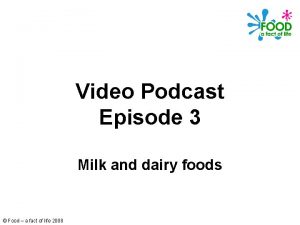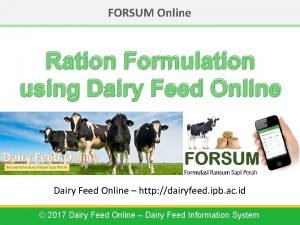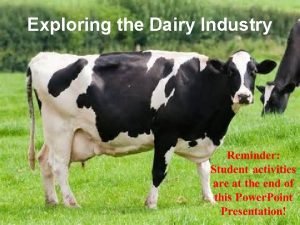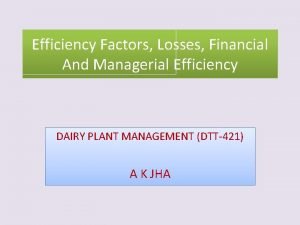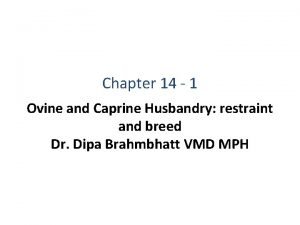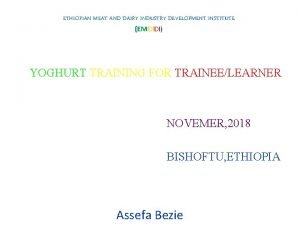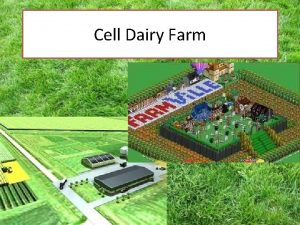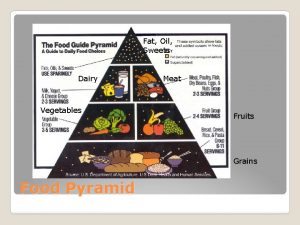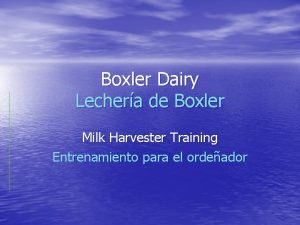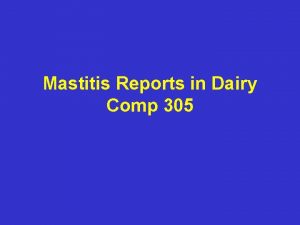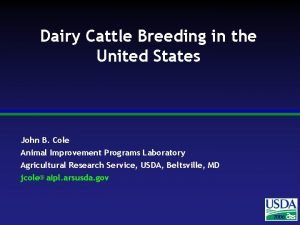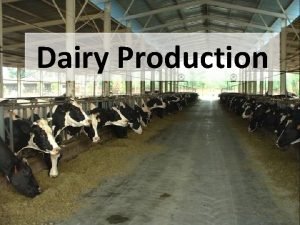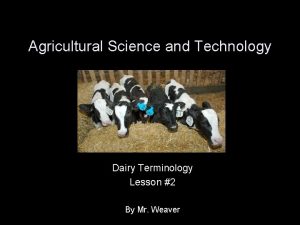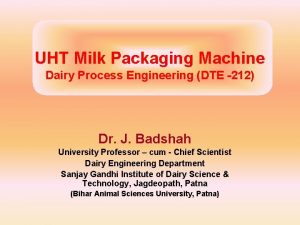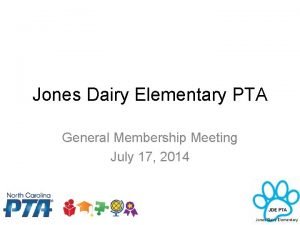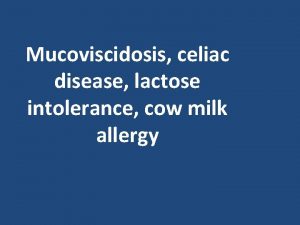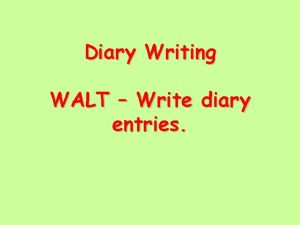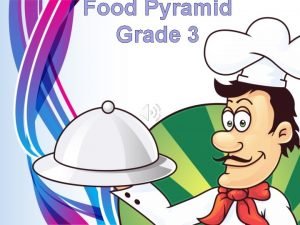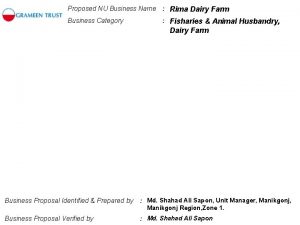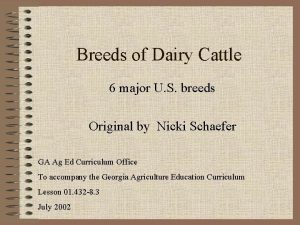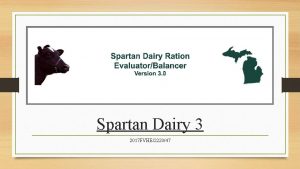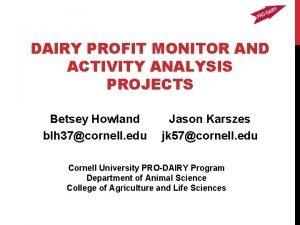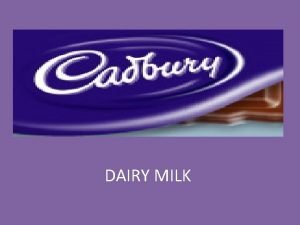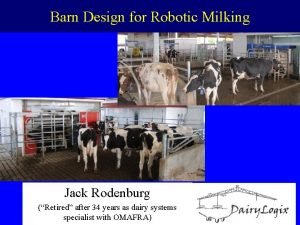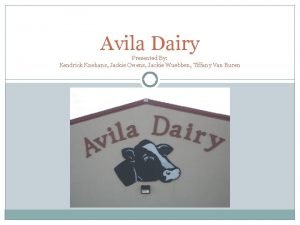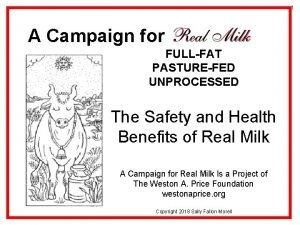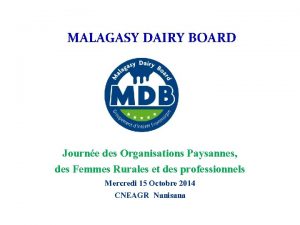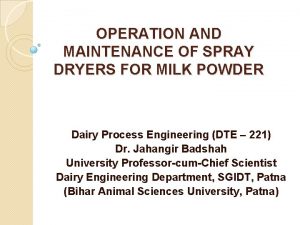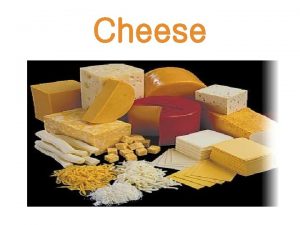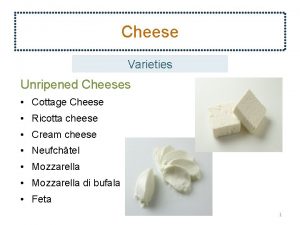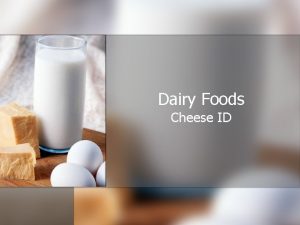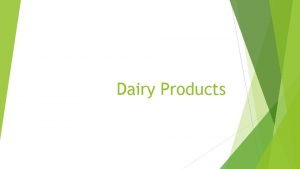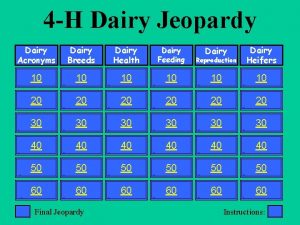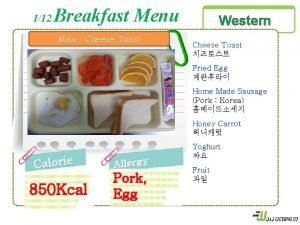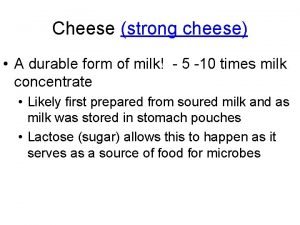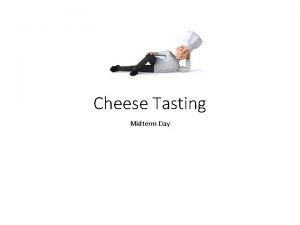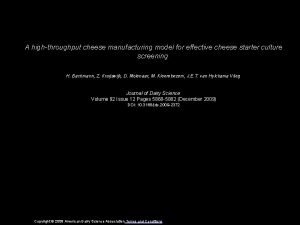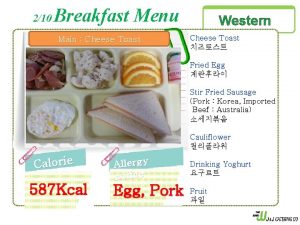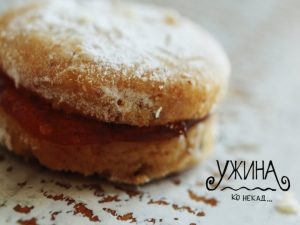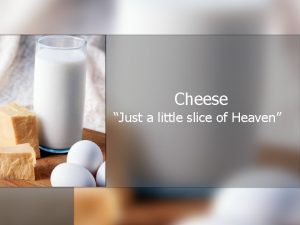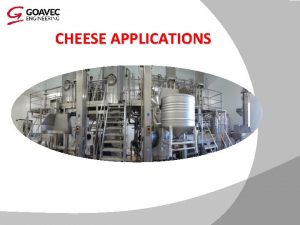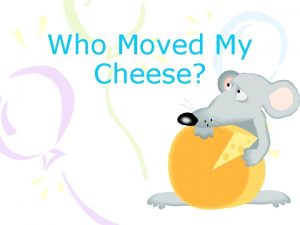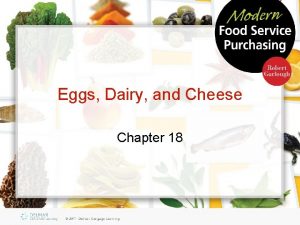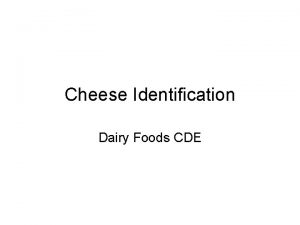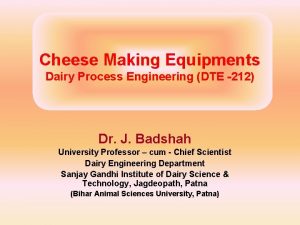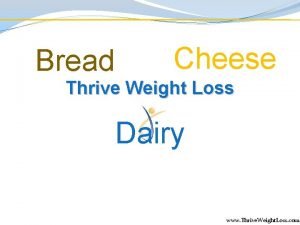Cheese What is cheese Cheese is a dairy

































- Slides: 33

Cheese







What is cheese? Cheese is a dairy product that is made from milk. Cows eat grass and produce milk for their calves because their young stomachs aren’t able to digest grass. Other milks such as goat and buffalo milk are also used to make different types of cheese.

Types of cheese What types of cheese can you think of? Wensleydale Gouda Cheesestrings Cream cheese Cheddar Brie Stilton Red Leicester

What are the blue bits? ! Before the invention of fridges to keep food cool, cheese had to be preserved naturally and so many cheeses contained edible moulds that grew through the cheese and prevented the growth of any harmful bacteria or moulds. Blue Stilton is an English cheese that gains its characteristic strong smell and taste from an edible blue mould called Penicillium roqueforti and Penicillium glaucum.

So how do you turn milk into cheese? 1. Acidification 3. Cutting and cooking Bacteria or acid The curds are cut with a are added to milk rake or knife and to convert the heated to release + or + sugars in milk, more whey. called lactose into Milk Acid Heat Bacteria lactic acid. Liquid (whey) 2. Coagulation Rennet contains a special enzyme called Chymosin, which begins to make the proteins and fat join together into curds Liquid and the liquid to (whey) separate into whey. Milk 4. Shaping and preserving Once the liquid has been + Rennet removed the cheese is shaped and preserved with salt or in a salt Fats and liquid called brine. proteins (curds) Curd rake Fats and proteins (curds)

Create a word bank! What new words have you come across?

Activity one Making Mozzarella

Important: Scientists do not eat their experiments! Ingredients checklist Equipment checklist • 1 litre full fat milk • 30 ml of lemon juice • 5 ml of rennet • • • 2 litre plastic pot or jug 1 litre plastic measuring jug Disposable plastic or paper cup Sieve or sock 2 Plastic spatulas or spoons 1 plastic plate • ~500 ml ice cold brine

Method 1. Pour 1 litre of milk into your pot or jug 2. Stand your pot in the water bath to heat your milk to 30ᵒC. Check the temperature is correct by using thermometer. 30ᵒC

3. Take the pot out of the water bath and gently stir in the lemon juice. 4. Return your pot to the water bath (30ᵒC) and leave for 10 minutes. Be sure to monitor the water bath temperature, it must not go below 30ᵒC or above 35ᵒC. 30ᵒC Is the mixture changing? Check the colour, smell and consistency

5. Place your pot in the HOT (~55 o. C )water 6. Meanwhile, add 40 ml of cold water to a cup, mix in 5 ml of rennet. bath. 55ᵒC

7. Remove your milk from the water bath and add the rennet and water mixture, stirring gently. Then place back in the hot water bath for 10 minutes. 55ᵒC Is the mixture changing? Check the colour, smell and consistency 8. Take the pot out of the water bath. Use a spatula to separate the curds from the edge of the pot. If it doesn’t separate from the edge of the pot cleanly, place the pot back in the water bath for another 5 -10 minutes.

9. Put the sieve over the measuring jug. Pour the curds and whey through the Sieve, using the spatula to gently move the curds to allow the whey to drain through. Place the jug containing the whey to one side, you will need this later. 10. Tip the curds onto the plate. Using the microwave, heat the curds until they are hot.

11. Use the spatula to knead and squash the curds, pour the excess whey off the plate into the same measuring jug as before (keep this for later). ! Careful ! Hot !! 12. Fold the curds into themselves and repeat the kneading. The curds will become a solid mass and can be kneaded by hand if not too hot.

13. Pull the ball of curds so that it stretches out. Once you have stretched the curds out a few times you can divide the mass into 4 balls. 14. Add some ice-cold brine (salt water) to the plastic pot and drop the mozzarella balls in.

15. Leave for a few minutes and then place the mozzarella on a plate. How does your cheese compare to the shop bought Mozzarella? Can you identify some of the main stages of cheese making? …. For example, acidification.

What is the fat percentage of your cheese? What you will need • Your measuring jug full of whey • Calculator Step 1. Work out the total volume of liquid you started with (milk & lemon & rennet mix) % Step 2. Subtract the volume of whey collected in the jug away from the total volume. You started with 1 litre of full fat milk that contains 3. 5% fat, that's 35 g fat. We assume there’s no fat left in the whey, it’s all in the curds. Step 3. Divide the starting amount of fat by the remaining volume (once the whey has been subtracted). Then multiply by 100. This is the percentage of fat in your cheese! How does it compare to the shop bought?

Writing Activity

Poetry During this session we will use the concepts, experiences, images and new vocabulary from the science as a starting point for writing poetry! What you will need: Pen/pencil Paper lined or plain Your word bank Science images

The big cheese: Blue Stilton I am the big cheese around here I’ve been the kingpin for quite some time I’m a blue-veined number one, son of a gun. Sitting here just waiting for my moment. I know they are coming for me soon With their big curved knives And their cheese wires And their crackers and chutney. If they think it’s gonna be easy Then they got me all wrong Sure I’ve gone a bit crumbly at the edges Anybody would, sitting here in the cooler alone In the dark, day after day, week after week, Just waiting for them to come. But they’ll find out soon enough I’m stronger, tougher, harder to handle Than I ever was before. I can smell my power and strength. I’m no soft touch, cream cheese kind of guy. No sirree, I ain’t the kind of cheese you stick fruit in. I’m the real thing. The original Extra mature, that’s what they call me. Like I said, I’m the big cheese around here. Nobody better forget that. I deserve some respect. I’m a cheese of distinction. I got taste, real taste. When the time comes I’ll be putting up quite a fight Sure they can cut me Burn me under the grill The can grate me to pieces Smear me with pickles It doesn’t matter what they do They’ll see I can still bite back Maybe they’ll find out they’ve bitten off More than they can chew. I’m ready. Come and get me, If you dare! By Mike O’Driscoll

Cheese inspired poetry What would it be like to be a cheese? Things to consider; What type of cheese would you be? Where would you be? – in the fridge, a sandwich or maybe you are still being made? How do you feel, and why? Use your word bank we created earlier to help you create your poem.

Art Activity One Blind taste test

Blind taste test What you will need: Blind fold Selection of cheeses Fork or cocktail stick Using your remaining senses; taste, touch and smell, explore the selection of cheeses. Can you identify any of them? Which one smells the strongest? Which is your favourite and why? Try describing one of the cheeses to someone near you and see if they can guess which one you are describing.

Art Activity Two Microscopic structures

Microscopic structures What you will need: Pen/pencil Paper lined or plain Science images What shapes and structures can you see? Sketch a sculpture inspired by the structures you can see in the science images.

Art Activity Three Clay sculptures

Clay Sculptures What you will need: Clay Sculpting tools Your sculpture sketch Using your cheese structure inspired sketch, create your own clay sculpture. Think about the shape and size of your sculpture. What different textures can you create with the sculpting tools?
 Dairy foods list
Dairy foods list Dairy feed online
Dairy feed online Vreba hoff dairy
Vreba hoff dairy Dairy plant efficiency
Dairy plant efficiency Ovine and caprine
Ovine and caprine Sundale dairy
Sundale dairy Emdidi
Emdidi Is dairy fattening
Is dairy fattening The outer fence of the plant cell
The outer fence of the plant cell Wastewater treatment for dairy industry
Wastewater treatment for dairy industry Dairy meat fruit vegetables and grains
Dairy meat fruit vegetables and grains Boxler dairy farm
Boxler dairy farm Bestmilk a typical profit-maximizing dairy firm
Bestmilk a typical profit-maximizing dairy firm Dairy comp 305
Dairy comp 305 National dairy council
National dairy council Objective of dairy farming
Objective of dairy farming Dairy cattle terminology
Dairy cattle terminology Uht packaging machine
Uht packaging machine Map milk ladder
Map milk ladder Jones dairy elementary
Jones dairy elementary Milk for toddlers with milk allergynon dairy
Milk for toddlers with milk allergynon dairy In which tense should a diary entry be written
In which tense should a diary entry be written Food pyramid for grade 6
Food pyramid for grade 6 Dairy farm business names
Dairy farm business names 6 breeds of dairy cattle
6 breeds of dairy cattle Sparta dairy
Sparta dairy Dairy profit monitor
Dairy profit monitor Etaloc
Etaloc What is a symbol in literature?
What is a symbol in literature? Norbco gates
Norbco gates Avila dairy equipment
Avila dairy equipment Wasteland dairy framework
Wasteland dairy framework Mdb madagascar
Mdb madagascar Spray dryers for milk powder
Spray dryers for milk powder
